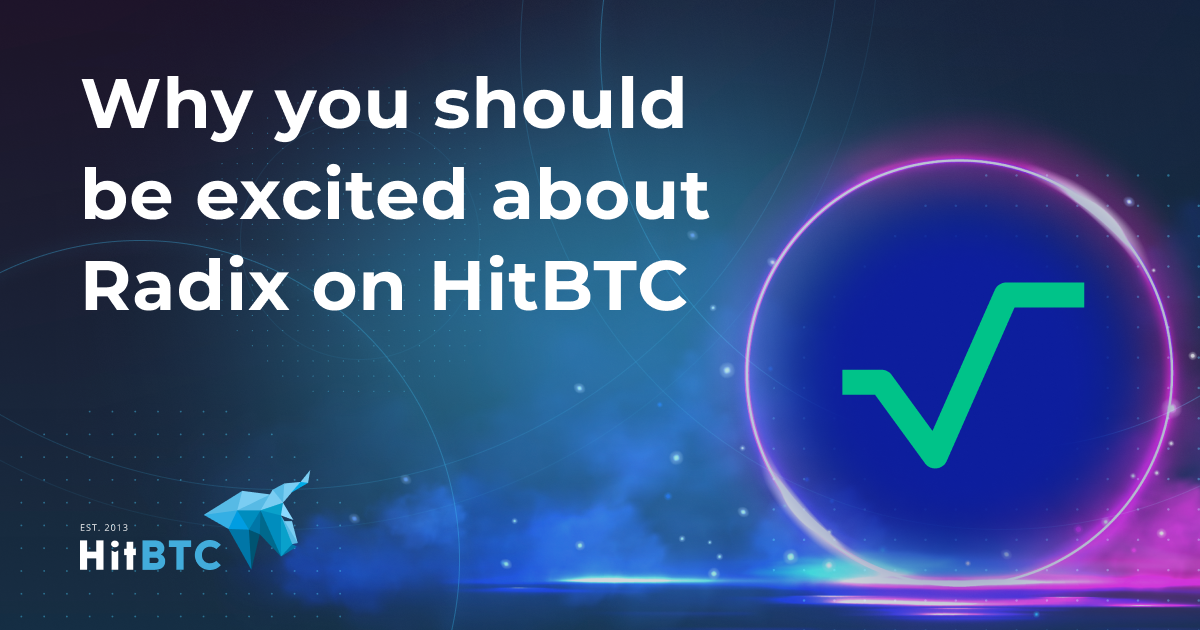Why you should be excited about Radix on HitBTC

HitBTC is delighted to announce that XRD, the native token of the Radix network, is now available on its platform. XRD is used to secure the Radix network by staking it in its delegated proof of stake mechanism. Users can pay transaction fees in the Radix network only with XRD, and it can be also used as a medium of exchange.
XRD is currently available on HitBTC for spot trading in XRD/BTC and XRD/USDT trading pairs.
The addition of XRD to HitBTC is one additional step in improving access to the Radix network, which already has an ecosystem of 130+ projects in development and 750+ tokens (and growing). The Radix network is poised to launch live smart contracts as part of its “Babylon” upgrade in Q2 2023.
About Radix
Radix is the smart contract platform with a radically better experience for users, developers, and capital. After 10 years of engineering, Radix’s full stack of technologies are now poised to begin growing its DeFi and Web3 ecosystem for mainstream users and developers.
There are three reasons why:
1. A Radically Better User Experience
The Web3 and decentralized finance (DeFi) user experience today is wholly inadequate. From blind signing your Bored Ape away, to billions of dollars of hacks and exploits, it seems that every week crypto gets hacked, lost or stolen. Web3 will not go mainstream with the user experience offered by today’s smart contract platforms.
Common errors, such as misplaced seed phrases, can lead to users permanently losing their funds (with an estimated 20% of Bitcoin already lost in this way).
To massively improve user experience, Radix had to re-engineer the entire concept of a smart contract platform from bottom to top. You can’t fix blind signing if the platform doesn’t have “native assets”. You can’t fix seed phrases if you don’t have “smart accounts” on the ledger (native account abstraction).
Radix launches five platform-level innovations that will dramatically improve user experience in Q2 2023:
- Smart Accounts
- Personas
- Radix Connect
- Native Assets
- Transaction Manifests
Finally, using Web3 will feel as easy and safe as your banking app.
2. A Radically Better Programming Experience
Currently, developing in Decentralized Finance (DeFi) and Web3 is challenging. It can take years for developers to gain enough experience to build production dApps, and even then, they can fall victim to hacks and exploits that amount to billions of dollars. This issue is not because of a lack of talented developers in the industry, but rather due to the inadequate tools available to them. These tools are not suitable for the levels of trust required for managing $400 trillion of finance.
The fundamental issue is that existing platforms do not understand what an asset is. Tokens are just variables (numbers) listed inside a smart contract created by a developer. Any updates to the balance of tokens are entirely dependent on the developer's logic, with the platform blindly following the logic. If a developer makes even a minor mistake, the tokens inside the smart contract can be lost, and there are no platform-level validations or safeguards to prevent such occurrences.
Consequently, according to a survey of almost 1,000 Web3 developers by RDX Works, developers spend 80% of their time securing and validating their code and only 20% of their time on the actual functionality they want. However, Radix's Scrypto programming language, coupled with the Radix Engine virtual machine, allows developers to build what they want without worrying about the low level security and validations required to make their smart contract safe (and even then we still see developer’s smart contracts getting hacked).
The Scrypto programming language, combined with Radix Engine, is a new developer experience that aims to make it easier and faster for developers to learn, build, and launch projects on the Radix Network without compromising security.
To learn more, see The Problem With Smart Contracts Today.
3. A Radically Better Experience for Capital
For DeFi and Web3 to outcompete the existing financial infrastructure, an unlimited number of users must be able to deploy their capital (tokens) to any combination of decentralized applications (dapps) quickly, seamlessly, and with low fees. In other words, the platform must be scalable.
However, current scalability solutions fall short. They either reach a scalability limit, not able to process more transactions than a single computer (vertical scaling); or they scale through “sharding” or “layer 2” solutions (horizontal scaling), which breaks “atomic composability” between the shards or layer 2s. Atomic composability is the ability for all parts of a transaction to settle together, so users are not left part way through a transaction with an asset that they don’t want. Sacrificing atomic composability fragments ecosystems resulting in a poor experience for users, developers, and capital.
Radix’s scalability solution Cerberus was developed over 2013 to 2020. It is not a blockchain, and is an entirely novel kind of consensus algorithm that allows for infinite linear scalability while retaining atomic composability across the entire ledger. The sharded form of Cerberus will be released as part of the Radix Xi'an mainnet update, currently scheduled for 2024.
To learn what makes Cerberus unique, check out the Cerberus Infographic Series.
To learn more about Radix, be sure to watch the RadFi keynote here.
